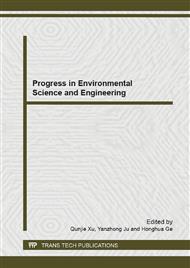p.1146
p.1150
p.1155
p.1162
p.1166
p.1170
p.1176
p.1188
p.1194
Rapid and Sensitive Competitive Fluorescence Immunoassay for the Detection of Chlortetracycline Residues in Environment
Abstract:
An direct competitive immunofluorescence method was developed in plate to detect chlortetracycline residues in environment using the Lumichrome as fluorescent probe. Different reaction conditions such as pH , the concentration of antigen and antibody and incubation times were assayed. Under optimized conditions, chlortetracycline can be determined in the concentration range of 1×10-8--2×10-4 mol/L, and the linear equation was y=11.363x+93.026, R2=0.99. The detection limit of this method IC90 was 3.74×10-7mol/L. The recoveries of chlortetracycline at various spiking levels in the sludge samples ranged from 95.43% to 104.26%, with relative standard deviations of 3% to 6%. These data demonstrate that the excellent performance of the proposed method in the detection of chlortetracycline in water samples.
Info:
Periodical:
Pages:
1166-1169
Citation:
Online since:
December 2012
Authors:
Keywords:
Price:
Сopyright:
© 2013 Trans Tech Publications Ltd. All Rights Reserved
Share:
Citation:


